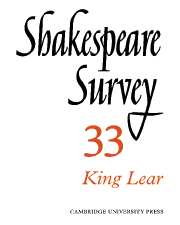Book contents
- Frontmatter
- King Lear: A Retrospect, 1939–79
- Some Conjectures on the Composition of King Lear
- The War in King Lear
- King Lear: Art Upside-Down
- ‘And that’s true too’: King Lear and the Tension of Uncertainty
- The Taming of the Shrew and King Lear: A Structural Comparison
- Medium and Message in As You Like It and King Lear
- Playing King Lear: Donald Sinden talks to J. W. R. Meadowcroft
- Hamlet’s Special Providence
- Antony and Cleopatra: ‘The Time of Universal Peace’
- Patterns of Motion in Antony and Cleopatra
- Theme and Structure in The Winter’s Tale
- Peter Street at the Fortune and the Globe
- English Actors at the Courts of Wolfenbüttel, Brussels and Graz during the Lifetime of Shakespeare
- Shakespeare at Stratford and the National Theatre, 1979
- The Year's Contributions to Shakespearian Study 1 Critical Studies
- 2 Shakespeare’s Life, Times, and Stage
- 3 Textual Studies
- Index
- Plate Section
The Taming of the Shrew and King Lear: A Structural Comparison
Published online by Cambridge University Press: 28 March 2007
- Frontmatter
- King Lear: A Retrospect, 1939–79
- Some Conjectures on the Composition of King Lear
- The War in King Lear
- King Lear: Art Upside-Down
- ‘And that’s true too’: King Lear and the Tension of Uncertainty
- The Taming of the Shrew and King Lear: A Structural Comparison
- Medium and Message in As You Like It and King Lear
- Playing King Lear: Donald Sinden talks to J. W. R. Meadowcroft
- Hamlet’s Special Providence
- Antony and Cleopatra: ‘The Time of Universal Peace’
- Patterns of Motion in Antony and Cleopatra
- Theme and Structure in The Winter’s Tale
- Peter Street at the Fortune and the Globe
- English Actors at the Courts of Wolfenbüttel, Brussels and Graz during the Lifetime of Shakespeare
- Shakespeare at Stratford and the National Theatre, 1979
- The Year's Contributions to Shakespearian Study 1 Critical Studies
- 2 Shakespeare’s Life, Times, and Stage
- 3 Textual Studies
- Index
- Plate Section
Summary
In this essay, I wish to suggest that, in writing two of his plays, Shakespeare was more than usually aware of the sometimes complementary, sometimes opposing functions of the mind and the body in human life; and that this awareness may be discerned in the layout of the narrative – the overall design – in the characterisation, and in the language: not simply the diction, but also the choice of sentiments to be uttered. I do not suggest that a reliance on these concepts accounts for every aspect of the plays’ structure, nor that Shakespeare may not have had other guiding principles, too. But I hope that an analysis of the plays with these ideas in mind may tell us something about how they are made; I hope, too, that the juxtaposition of two essentially very different plays may also be fruitful.
The relationship between mind, or soul, and body was a common topic in Renaissance writings about religion, philosophy, morality, and physiology. There is, to give just one example, an essay about it in Plutarch's Moralia which, interestingly enough, first appeared in English translation (by Philemon Holland) in 1603, shortly before the composition of King Lear, though I can find no evidence of direct relationship. Shakespeare has many glancing references to the theme, and some longer treatments of it. The plays with which I am concerned are not the only ones to which, I believe, it can provide a useful critical approach.
- Type
- Chapter
- Information
- Shakespeare Survey , pp. 55 - 66Publisher: Cambridge University PressPrint publication year: 1981



